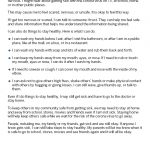Section 6: Practical Strategies across Settings
188 Social Narratives
 Social narratives are similar to Social Stories® described in other sections. However, the narratives are procedurally less structured and prescriptive making them a bit easier to create and implement. The narratives help individuals to successfully navigate situations that are overly complex or challenging. They begin by describing the negative or challenging situation. The narratives reassure (e.g., “it’s ok”) and provide a concrete plan of action for the individual in facing the situations in the short or longer-term future with decreased anxiety and increased assurance that all will work out fine.
Social narratives are similar to Social Stories® described in other sections. However, the narratives are procedurally less structured and prescriptive making them a bit easier to create and implement. The narratives help individuals to successfully navigate situations that are overly complex or challenging. They begin by describing the negative or challenging situation. The narratives reassure (e.g., “it’s ok”) and provide a concrete plan of action for the individual in facing the situations in the short or longer-term future with decreased anxiety and increased assurance that all will work out fine.
Other Practical Tips
- Prepare the individual by beginning to read the narrative days or even weeks prior to an event and/or immediately prior and even intermittently if a longer lasting event.
- Social narratives may not be for everyone, but can be written for a variety of reading, attention, and interest levels.
- Social narratives can be created and/or shared across various caregivers and settings with the same individual or group of individuals.
- It may help to keep pre-written narratives available for situations that can be commonly challenging for most individuals with ASD or otherwise to use proactively (e.g., waiting for the bus, going on vacation, out of school/work due to illness).
Why Should I Implement Social Narratives?
- Social narratives are a proactive approach to decreasing anxiety.
- Proper use may reduce behaviors exhibited by many individuals due to their anxiety and uneasiness in complex or challenging situations.
- Social narratives provide information and recite a plan in a concrete, consistent, and repeated fashion across caregivers, settings, and contexts.
How do I make a Social Narrative?
- Social narratives should be written from the perspective of the individual (e.g. I can sit with my hands in my lap).
- Use simple language; avoid using jargon or abstract concepts.
- Provide concrete examples of what the individual is likely to experience.
- Try to make the components of the social narrative directly follow the components of the actual event as closely as possible.
- For higher functioning individuals who may not want to read a narrative with pictures, convert the social narrative into a social script.
- Copy the text (either by handwriting or typing it) onto a new sheet of paper.
- Do not add any photographs.
- The content of the text may or may not need to be altered.
General Guidelines for Social Narrative Use
Adapted from Gray C. (2000). The new social story book. Arlington, TX: Future Horizons; White, A., & Gray, C. (2002). My social story book. London: Jessica Kingsley.
- Introduce the narrative in a way that is reassuring the individual.
- Never review a social narrative as a punishment for misbehavior.
- Be honest about the purpose of the story. Say, “I have a story about going to school. It is time for us to read it together.”
- Have a positive attitude so the individual associates the narrative with calm and relaxing language.
- If several narratives are being used, review them one at a time.
- Review the narrative at least once per day leading up to the event it describes.
- Adjust the frequency and length of review based on the individual’s needs.
- Fade the narrative (gradually reducing its use) based on the individual’s needs.
-
- Leave out the sentences with content the individual has learned.
- Rewrite the sentences to remove ideas that have been learned.
- Space out the review: instead of daily, review it every other day.
Sample Social Narrative: Coronavirus and Staying Healthy






